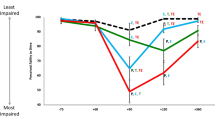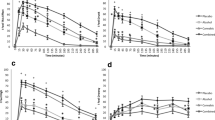Abstract
Rationale
The party drug ecstasy is frequently used in combination with other drugs like marihuana and alcohol. In addition, a substantial proportion of the MDMA users has claimed to drive a car when under the influence of MDMA and/or other drugs.
Objective
To assess the effects of MDMA and alcohol, combined and alone, on actual driving performance and laboratory tasks related to driving.
Methods
Eighteen healthy subjects participated in a double-blind, placebo-controlled, six-way cross-over study. Treatments consisted of MDMA 0, 75, and 100 mg with and without alcohol, aiming at 0.06 mg/ml BAC. Laboratory tests (critical tracking task, object movement estimation task) were conducted between 1.5 and 2 h postdrug (0.5 and 1 h postalcohol). Actual driving tests (road tracking test, car-following test) were conducted between 3 and 5 h postdrug (2 and 4 h postalcohol). Subjects completed the addiction research center inventory (ARCI) and rated their driving quality and mental effort during driving.
Results
Alcohol alone impaired critical tracking performance, as well as a number of actual driving performance parameters [i.e., standard deviation of lateral position (SDLP), brake reaction time, and coherence]. MDMA alone reduced SDLP and standard deviation of speed. MDMA significantly moderated alcohol induced impairment of road tracking performance but did not affect alcohol impairments of car-following and laboratory task performance. Subjective data seemed to support objective data.
Conclusion
MDMA moderated the impairing effects of a low dose of alcohol on road tracking performance but it could not overcome alcohol-induced impairment on other aspects of driving behavior or driving related performance.



Similar content being viewed by others
References
Barrett SP, Gross SR, Garand I, Pihl RO (2005) Patterns of simultaneous polysubstance use in Canadian rave attendees. Subst Use Misuse 40(9-10): 1525–1537
Brookhuis KA, de Waard D, Mulder B (1994) Measuring driving performance by car-following in traffic. Ergonomics 37:427–434
Brookhuis KA, De Waard D, Samyn N (2004) Effects of MDMA (ecstasy), and multiple drugs use on (simulated) driving performance and traffic safety. Psychopharmacology 173:440–445
Carmen del Rio M, Gomez J, Sancho M, Alvarez FJ (2002) Alcohol, illicit drugs and medicinal drugs in fatally injured drivers in Spain between 1991 and 2000. Forensic Sci Int 127:63–70
de la Torre R, Farre M, Ortuno J, Mas M, Brenneisen R, Roset PN, Sequra J, Cami J (2000) Non-linear pharmacokinetics of MDMA (‘ecstasy’) in humans. Br J Clin Pharmacol 49:104–109
de la Torre R, Farre M, Roset PN, Pizarro N, Abanades S, Segura M, Segura J, Cami J (2004) Human pharmacology of MDMA: pharmacokinetics, metabolism, and disposition. Ther Drug Monit 26:137–144
de Wit H, Crean J, Richards JB (2000) Effects of d-amphetamine and ethanol on a measure of behavioral inhibition in humans. Behav Neurosci 114:830–837
Haertzen CA (1965) Addiction Research Center Inventory (ARCI): development of a general drug estimation scale. J Nerv Ment Dis 141:300–307
Henry JA (1992) Ecstasy and the dance of death. BMJ 305:5–6
Henry JA, Jeffreys KJ, Dawling S (1992) Toxicity and deaths from 3,4-methylenedioxymethamphetamine (“ecstasy”). Lancet 340:384–387
Hernandez-Lopez C, Farre M, Roset PN, Menoyo E, Pizarro N, Ortuno J, Torrens M, Cami J, de la Torre R (2002) 3,4-Methylenedioxymethamphetamine (ecstasy) and alcohol interactions in humans: psychomotor performance, subjective effects, and pharmacokinetics. J Pharmacol Exp Ther 300:236-244
Jex HR, McDonnell JD, Phatak AV (1966) A “critical” tracking task for man-machine research related to the operator’s effective delay time. I. Theory and experiments with a first-order divergent controlled element. NASA CR-616. NASA Contract Rep NASA CR: 1–105
Lamers CT, Ramaekers JG, Muntjewerff ND, Sikkema KL, Samyn N, Read NL, Brookhuis KA, Riedel WJ (2003) Dissociable effects of a single dose of ecstasy (MDMA) on psychomotor skills and attentional performance. J Psychopharmacol (Oxford, England) 17:379–387
Logan BK, Couper FJ (2001) 3,4-Methylenedioxymethamphetamine (MDMA, ecstasy) and driving impairment. J Forensic Sci 46:1426–1433
Mas M, Farre M, de la Torre R, Roset PN, Ortuno J, Segura J, Cami J (1999) Cardiovascular and neuroendocrine effects and pharmacokinetics of 3, 4-methylenedioxymethamphetamine in humans. J Pharmacol Exp Ther 290:136–45
O’Hanlon JF (1984) Driving performance under the influence of drugs: rationale for, and application of, a new test. BJCP Br J Clin Pharmacol 18(Suppl 1):121s–129s
Parrott AC (2004) Is ecstasy MDMA? A review of the proportion of ecstasy tablets containing MDMA, their dosage levels, and the changing perceptions of purity. Psychopharmacology 173:234–241
Ramaekers JG, Kuypers KP (2006) Acute effects of 3,4-methylenedioxymethamphetamine (MDMA) on behavioral measures of impulsivity: alone and in combination with alcohol. Neuropsychopharmacology Official Publication of the American College of Neuropsychopharmacology 31:1048–1055
Ramaekers JG, Kuypers KPC, Samyn N (2006) Stimulant effects of MDMA 75 mg and methylphenidate 20 mg on actual driving during intoxication and withdrawal. Addiction (in press)
Ramaekers JG, Robbe HWJ, O’Hanlon JF (2000) Marijuana, alcohol and actual driving performance. Hum Psychopharmacol 15:551–558
Read N, Ward N, Parkes A (2000) The role of dynamic tests in assessing the fitness to drive of healthy and cognitively impaired elderly. J Traffic Med 28:34S–35S
Riley SC, James C, Gregory D, Dingle H, Cadger M (2001) Patterns of recreational drug use at dance events in Edinburgh, Scotland. Addiction (Abingdon, England) 96:1035–1047
Schifano F (1995) Dangerous driving and MDMA (“ecstasy”) abuse. Journal Serotonin Res 1:53–57
Topp L, Hando J, Dillon P, Roche A, Solowij N (1999) Ecstasy use in Australia: patterns of use and associated harm. Drug Alcohol Depend 55:105–115
World Medical Organization. Declaration of Helsinki. Br Med J (7 December) 1996;313(7070):1448–1499
Zijlstra F (1993) Efficiency in work behavior. A design approach for modern tools. University of Technology, Delft, The Netherlands
Acknowledgements
We would like to thank Gert De Boeck and Marleen Laloup from NICC, Brussels, for analyzing MDMA blood plasma samples. We also would like to thank Kirsten Schuer, Lisa Willems, and Anita van Oers for their relative contribution to the study. This work was conducted as part of the IMMORTAL research consortium funded by EU grant GMA1-2000-27043.
Author information
Authors and Affiliations
Corresponding author
Rights and permissions
About this article
Cite this article
Kuypers, K.P.C., Samyn, N. & Ramaekers, J.G. MDMA and alcohol effects, combined and alone, on objective and subjective measures of actual driving performance and psychomotor function. Psychopharmacology 187, 467–475 (2006). https://doi.org/10.1007/s00213-006-0434-z
Received:
Accepted:
Published:
Issue Date:
DOI: https://doi.org/10.1007/s00213-006-0434-z




